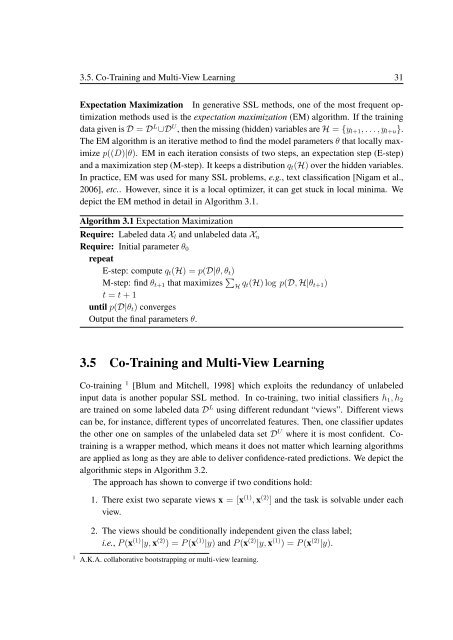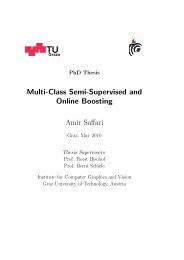PhD Thesis Semi-Supervised Ensemble Methods for Computer Vision
PhD Thesis Semi-Supervised Ensemble Methods for Computer Vision
PhD Thesis Semi-Supervised Ensemble Methods for Computer Vision
Create successful ePaper yourself
Turn your PDF publications into a flip-book with our unique Google optimized e-Paper software.
3.5. Co-Training and Multi-View Learning 31<br />
Expectation Maximization In generative SSL methods, one of the most frequent optimization<br />
methods used is the expectation maximization (EM) algorithm. If the training<br />
data given is D = D L ∪D U , then the missing (hidden) variables are H = {y l+1 , . . . , y l+u }.<br />
The EM algorithm is an iterative method to find the model parameters θ that locally maximize<br />
p((D)|θ). EM in each iteration consists of two steps, an expectation step (E-step)<br />
and a maximization step (M-step). It keeps a distribution q t (H) over the hidden variables.<br />
In practice, EM was used <strong>for</strong> many SSL problems, e.g., text classification [Nigam et al.,<br />
2006], etc.. However, since it is a local optimizer, it can get stuck in local minima. We<br />
depict the EM method in detail in Algorithm 3.1.<br />
Algorithm 3.1 Expectation Maximization<br />
Require: Labeled data X l and unlabeled data X u<br />
Require: Initial parameter θ 0<br />
repeat<br />
E-step: compute q t (H) = p(D|θ, θ t )<br />
M-step: find θ t+1 that maximizes ∑ H q t(H) log p(D, H|θ t+1 )<br />
t = t + 1<br />
until p(D|θ t ) converges<br />
Output the final parameters θ.<br />
3.5 Co-Training and Multi-View Learning<br />
Co-training 1 [Blum and Mitchell, 1998] which exploits the redundancy of unlabeled<br />
input data is another popular SSL method. In co-training, two initial classifiers h 1 , h 2<br />
are trained on some labeled data D L using different redundant “views”. Different views<br />
can be, <strong>for</strong> instance, different types of uncorrelated features. Then, one classifier updates<br />
the other one on samples of the unlabeled data set D U where it is most confident. Cotraining<br />
is a wrapper method, which means it does not matter which learning algorithms<br />
are applied as long as they are able to deliver confidence-rated predictions. We depict the<br />
algorithmic steps in Algorithm 3.2.<br />
The approach has shown to converge if two conditions hold:<br />
1. There exist two separate views x = [x (1) , x (2) ] and the task is solvable under each<br />
view.<br />
2. The views should be conditionally independent given the class label;<br />
i.e., P (x (1) |y, x (2) ) = P (x (1) |y) and P (x (2) |y, x (1) ) = P (x (2) |y).<br />
1 A.K.A. collaborative bootstrapping or multi-view learning.



